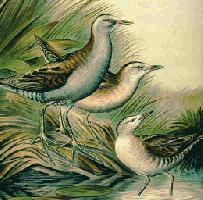
Greutăți și măsuri
| Lungime | de la 32 la 35 cm |
|---|---|
| Greutate | de la 310 la 456 g |
| Lungimea anvergurii aripilor | de la 54 la 62 cm |
Date biologice
| Durata de viață | de la 10 la 11 ani |
|---|
Starea de conservare
| Neînfricat |
Descrierea animalului
The Common Moorhen (Gallinula chloropus) is a distinctive waterbird belonging to the rail family, Rallidae. It is a medium-sized bird, measuring approximately 30 to 35 centimeters in length, with a wingspan ranging from 50 to 60 centimeters. This species is notable for its widespread distribution, found across many parts of the world including Europe, Asia, Africa, and the Americas, inhabiting a variety of freshwater environments such as lakes, rivers, marshes, and ponds.One of the most striking features of the Common Moorhen is its plumage. The bird boasts a predominantly slate-black to dark gray body, which contrasts sharply with the white undertail coverts and the distinctive white line along its flanks. The head and neck may appear almost black, and there is often a bluish-purple sheen on the upper parts, especially noticeable under certain lighting conditions. Juveniles and immature birds, however, present a much browner appearance with less distinctive markings.
The Common Moorhen has a bright red frontal shield and bill, which is tipped with yellow, making it one of the most recognizable features of the species. This colorful facial ornamentation is not only a key identifier but also plays a role in social interactions and mating displays.
Equipped with strong legs and long toes, the Common Moorhen is adept both in water and on land. Its feet are not fully webbed, unlike those of ducks, but instead have lobed toes that aid in swimming and navigating through thick vegetation. This adaptation allows it to forage efficiently, feeding on a varied diet that includes aquatic plants, seeds, fruit, insects, small fish, and amphibians.
The bird is known for its vocalizations, producing a variety of sounds ranging from short, sharp calls to more prolonged, moaning notes that are often heard during the breeding season. These calls serve various purposes, including communication between mates, signaling alarm, and establishing territory.
Breeding behavior of the Common Moorhen is quite interesting. It is a monogamous species, with pairs forming strong bonds. The nest is a substantial structure, built from plant material and often situated in dense vegetation near or on the water. The female typically lays between 5 to 8 eggs, which are incubated by both parents. The chicks are precocial, hatching with their eyes open and covered in down, ready to leave the nest within a day after hatching. Both parents are involved in feeding and protecting the young until they are independent.
Despite facing threats from habitat destruction, pollution, and predation, the Common Moorhen has shown remarkable adaptability, often thriving in human-altered landscapes where suitable wetland habitat remains. This resilience, combined with a broad geographic range, has helped the Common Moorhen maintain a stable population, classifying it as Least Concern on the IUCN Red List of Threatened Species.
In summary, the Common Moorhen is a fascinating and adaptable bird, easily recognized by its distinctive coloration and vocalizations. It plays a significant role in the ecosystems of wetlands across the globe, contributing to the biological diversity and health of these vital habitats.
Harta răspândirii

Animale similare
Fotografii noi cu animale
Top 10 animale
- Dolphin gull (Leucophaeus scoresbii)
- Diana monkey (Cercopithecus diana)
- Moustached guenon (Cercopithecus cephus)
- Galápagos tortoise (Geochelone nigra complex)
- Stone loach (Barbatula barbatula)
- Greek tortoise (Testudo graeca)
- Japanese macaque (Macaca fuscata)
- Russian tortoise (Testudo horsfieldii)
- Common flying dragon (Draco volans)
- Galápagos penguin (Spheniscus mendiculus)


